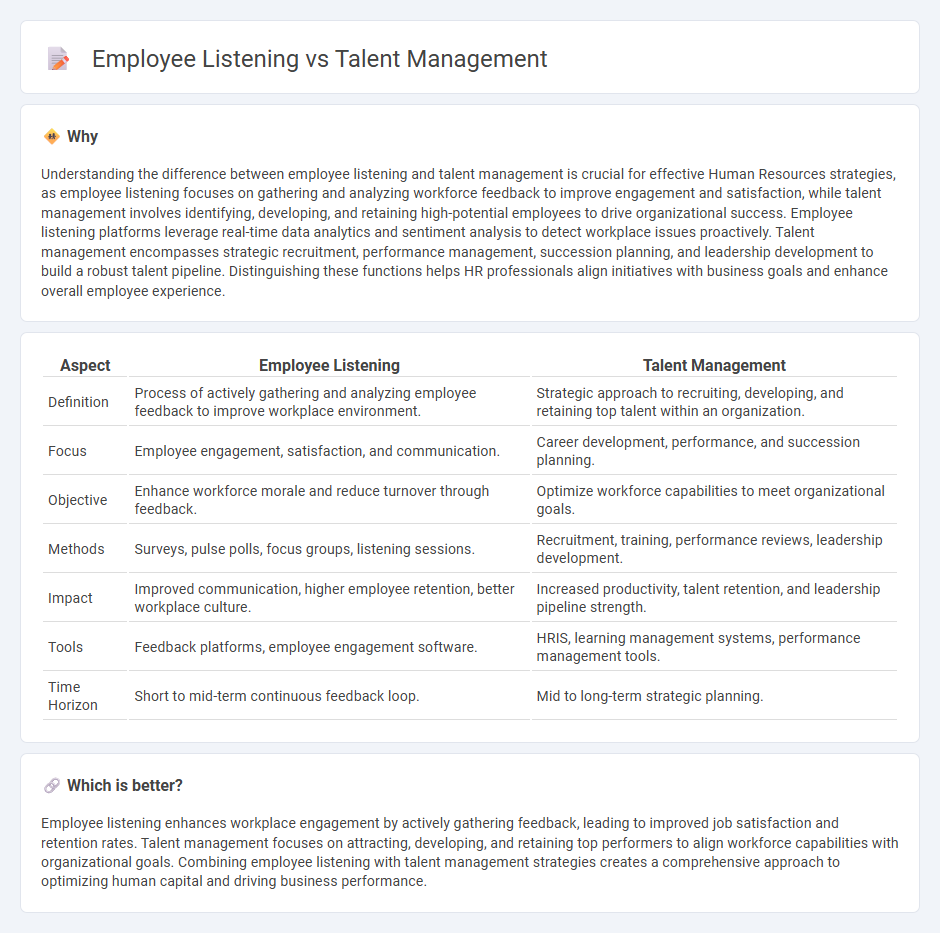
Employee listening gathers real-time feedback and insights to enhance workplace engagement and satisfaction, while talent management strategically focuses on recruiting, developing, and retaining skilled professionals to drive organizational success. Integrating employee listening with talent management creates a holistic approach that aligns employee needs with business goals, fostering a more productive and motivated workforce. Discover how combining these strategies can transform your human resources practices.
Why it is important
Understanding the difference between employee listening and talent management is crucial for effective Human Resources strategies, as employee listening focuses on gathering and analyzing workforce feedback to improve engagement and satisfaction, while talent management involves identifying, developing, and retaining high-potential employees to drive organizational success. Employee listening platforms leverage real-time data analytics and sentiment analysis to detect workplace issues proactively. Talent management encompasses strategic recruitment, performance management, succession planning, and leadership development to build a robust talent pipeline. Distinguishing these functions helps HR professionals align initiatives with business goals and enhance overall employee experience.
Comparison Table
| Aspect | Employee Listening | Talent Management |
|---|---|---|
| Definition | Process of actively gathering and analyzing employee feedback to improve workplace environment. | Strategic approach to recruiting, developing, and retaining top talent within an organization. |
| Focus | Employee engagement, satisfaction, and communication. | Career development, performance, and succession planning. |
| Objective | Enhance workforce morale and reduce turnover through feedback. | Optimize workforce capabilities to meet organizational goals. |
| Methods | Surveys, pulse polls, focus groups, listening sessions. | Recruitment, training, performance reviews, leadership development. |
| Impact | Improved communication, higher employee retention, better workplace culture. | Increased productivity, talent retention, and leadership pipeline strength. |
| Tools | Feedback platforms, employee engagement software. | HRIS, learning management systems, performance management tools. |
| Time Horizon | Short to mid-term continuous feedback loop. | Mid to long-term strategic planning. |
Which is better?
Employee listening enhances workplace engagement by actively gathering feedback, leading to improved job satisfaction and retention rates. Talent management focuses on attracting, developing, and retaining top performers to align workforce capabilities with organizational goals. Combining employee listening with talent management strategies creates a comprehensive approach to optimizing human capital and driving business performance.
Connection
Employee listening enhances talent management by providing real-time insights into workforce needs, satisfaction, and engagement levels. This data-driven feedback enables HR teams to tailor talent development, retention strategies, and performance management effectively. Integrating continuous employee listening mechanisms strengthens organizational agility and drives long-term human capital success.
Key Terms
**Talent Management:**
Talent management involves attracting, developing, and retaining top performers through strategic recruitment, continuous learning, and performance optimization processes. Key components include workforce planning, leadership development, and succession planning to align employee skills with organizational goals. Explore more to understand how talent management drives organizational success and workforce engagement.
Succession Planning
Succession planning within talent management emphasizes identifying and developing future leaders to ensure organizational continuity and resilience. Employee listening enhances this process by capturing real-time feedback on career aspirations and skill development needs, aligning succession strategies with actual employee potential and engagement levels. Explore how integrating these approaches can strengthen your succession planning initiatives.
Performance Appraisal
Talent management emphasizes structured performance appraisals to align employee skills with organizational goals, driving growth and retention. Employee listening prioritizes continuous feedback through surveys and one-on-one conversations to understand employee needs and improve engagement. Discover how integrating both approaches enhances performance appraisal effectiveness and overall workforce productivity.
Source and External Links
Talent Management: The Complete Guide - AIHR - Talent management involves HR strategies and processes aimed at attracting, developing, motivating, and retaining high-performing employees to drive organizational performance through integrated people management practices.
Talent Management - OPM - Talent management is a system that ensures organizations place the right people in the right positions at the right time by planning workforce needs, closing skills gaps, and retaining quality and diverse talent to support agency missions and sustained performance.
Talent Management - What Is It & Why Is It Important? - ADP - Talent management is the process of recruiting, developing, engaging, and retaining employees to optimize productivity and business performance through steps like workforce planning, hiring, onboarding, training, and performance monitoring.
 dowidth.com
dowidth.com